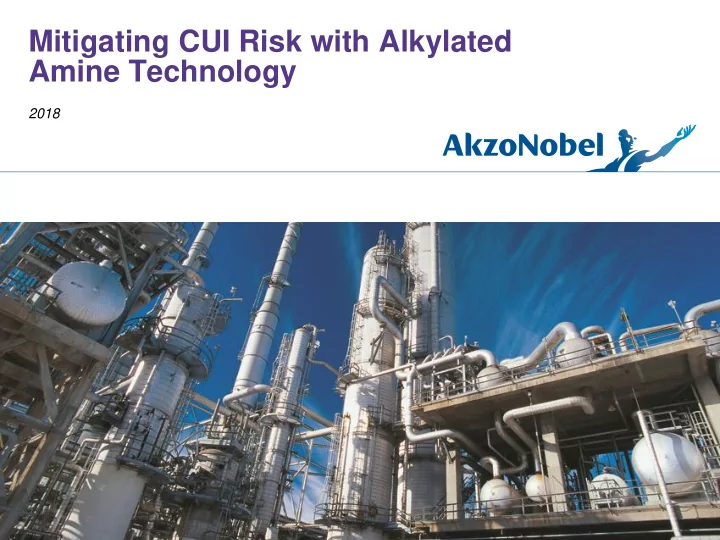

Mitigating CUI Risk with Alkylated Amine Technology 2018
Agenda • The Challenge • Introducing Alkylated Amine Technology • The Benefits • Summary Unless otherwise agreed in writing by AkzoNobel, all products supplied together with all technical service, information, advice and recommendations given are subject to our standard terms and conditions of sale which are available on request. Any information given here is for guidance only and is provided without any representation or warranty of any kind, express or otherwise. Further, AkzoNobel accepts no control or liability for the appropriateness of any product or the surface, structure or design to which our products are applied or the application process itself. You should seek independent expert advice as to the appropriateness of a particular design or structure for use of our products. We also strongly recommend that independent testing and/or assessment is carried out prior to the application of any product to determine suitability for use. Protective Coatings 2
The Challenge • Oil & Gas projects can involve thousands of pipe spools and valves • All require different coating schemes depending on service conditions • Such complexity can lead to coating application and installation errors Protective Coatings 3
The Challenge In the -196 ° C to 230 ° C (-320 ° F to 446 ° F) temperature range, two specialist products currently dominate conventional specifications, but present challenges for large complex projects. Modified Epoxy Epoxy Zinc Silicone Tie-Coat Silicate Mid-Coat Epoxy Epoxy Aluminium Novolac Silicone Phenolic
The Challenge • IOZs require careful controls (DFT and humidity) to ensure correct application • Industry guidance such as the NACE SP0198 standard discourages the use of IOZs under insulation due to the reverse polarity phenomenon that accelerates carbon steel corrosion < 175ºC Protective Coatings 5
NACE SP0198 Protective Coatings 6
The Challenge • Traditional epoxy phenolics are also known to be problematic: – Poor crack resistance if the dry film thickness is too high – Slow drying below 10ºC (50ºF) Lead to poor CUI resistance if not properly controlled Protective Coatings 7
The Challenge Traditional solutions are problematic Is there a better way? Protective Coatings 8
New Coating Technology Alkylated amine epoxy technology Temperature resistant from -196ºC (-321ºF) to 230 ° C (446 ° F) Protective Coatings 9
The Benefits Tolerance to over application Standard Epoxy Phenolic Standard Epoxy Phenolic Alkylated amine 2 x 175µm stoved at 200ºC 2 x 225µm stoved at 200ºC 2 x 350µm stoved at 200ºC Test consists of heating to 200ºC for 8hrs and leaving to cool to ambient for 16hrs; test is repeated 5 times
The Benefits Fast and low temperature curing = Productivity Increase 20 ° C (68ºF) ambient temperature Epoxy Phenolic System 50% faster application Alkylated Amine Time to apply system Temperature Touch dry Hard dry Min Overcoating Max. Overcoating -5 ° C (23ºF) 7 hrs (N/A) 10 hrs (N/A) 14 hrs (N/A) 14 days (N/A) 10 ° C (50ºF) 5 hrs (8 hrs) 8 hrs (16 hrs) 10 hrs (36 hrs) 14 days (5 days) 20 ° C (68ºF) 4 hrs (6 hrs) 6 hrs (10 hrs) 7 hrs (20 hrs) 14 days (3.5 days 35 ° C (95ºF) 2 hrs (4 hrs) 4 hrs (7 hrs) 4hrs (16 hrs) 10 days (2 days) Alkylated Amine in Black. Typical epoxy phenolic values in red Protective Coatings 11
The Benefits Excellent Corrosion Protection ISO 20340 Test Result Corrosion creep <3mm Blistering Rating 0 Rusting Rating 0 Cracking Rating 0 Adhesion >5 Mpa and <50% reduction Protective Coatings 12
High DFT capability – exterior exposure • In cyclic conditions, epoxy phenolic coatings are limited in corrosion resistance due to low maximum DFT. • Alkylated amine technology allows for additional thickness to be applied, reducing the frequency of re-painting. Typical Epoxy Alkylated Amine Phenolic 200µm 400µm total DFT Extra durability when in ambient conditions 100µm 200µm total DFT 200µm 100µm Protective Coatings 13
The Benefits Online Application – M&R Tolerance to M&R scenarios - hot application to 120 ° C No need to take the equipment out of service in order to carry out the coating application
The Benefits Reduced Specification Complexity Polyurethane Polyurethane * Polyurethane Epoxy Epoxy Epoxy Phenolic Epoxy Zinc Silicate Zinc Epoxy Epoxy Phenolic Steel Pipe Steel Pipe Steel Pipe Steel Pipe * Alkylated Amine Alkylated Amine Steel Pipe Carbon or stainless steel *Recommend topcoat for high UV/rainfall uninsulated environments.
Track Record Protective Coatings 16
Track Record 2016 Information >4,000L of Alkylated Amine was delivered for this project. Applied by Cameron in Italy, the product will be used on valves running at high temperature on the Yamal LNG Project in Russia. Project YAMAL LNG Project Site touch up down to – 5 ° C. Epoxy phenolic coatings would have required expensive Benefit heating arrangements. Protective Coatings 17
Track Record 2016 Information Myoungshinsa is a protective coatings distributor supplying applicators at the large DSME fabrication yard in Korea. >50,000 L Alkylated amine is being applied onsite over the course of 2018. Project Tengiz Oilfield Expansion Year round productivity where average daily temperature can be as low as 0 ° C. Benefit Protective Coatings 18
Summary Excellent CUI resistance + Excellent tolerance to over application + Fast and low temperature curing Protective Coatings 19
Summary All coupled together with specification complexity reduction mean: Alkylated Amine Technology Reduces risk Reduces CUI Protective Coatings 20
Thank You
Recommend
More recommend